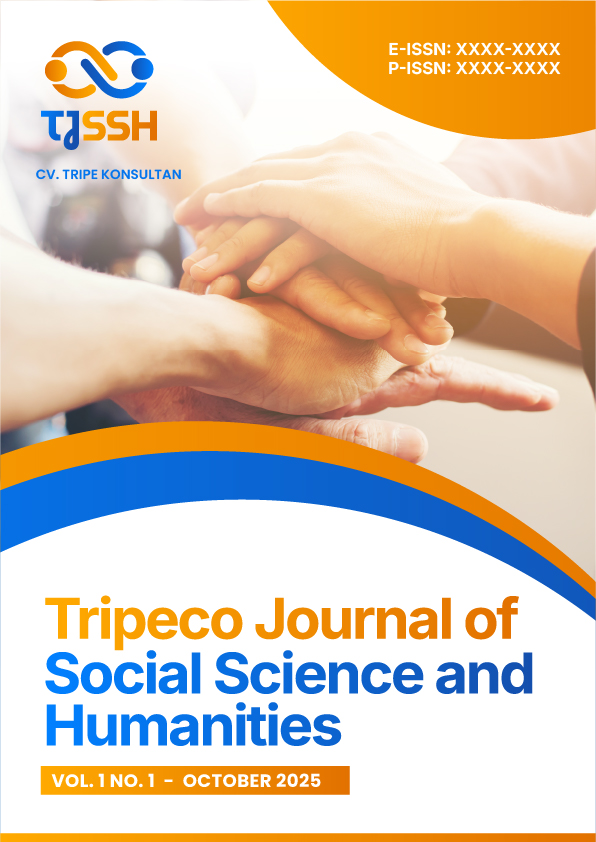The Evolution of Cybercrime in the Digital Era: Legal and Security Implications
 Abstract views: 71
Abstract views: 71
 PDF downloads: 64
PDF downloads: 64
Keywords:
Cybercrime, Legal Implications, CybersecurityAbstract
The evolution of cybercrime in the digital era has created significant threats and challenges in the fields of law and global security. These threats not only jeopardise individuals but also damage critical infrastructure and cause substantial economic losses. This research aimed to explore the evolution of cybercrime in the digital age, understand its legal implications, and analyse the challenges arising in maintaining cybersecurity at both global and national levels. The study adopts a literature analysis approach, collecting data from journal articles, books, official reports, as well as sources from international organisations and government agencies involved in cybersecurity. The subject of this research includes a literature review of various publications related to cybercrime, legal policies, and regulations implemented to combat cyber threats. The findings of this research show that cybercrime now involves attacks on critical infrastructure and large-scale data theft, with its impact expected to reach 10.5 trillion USD by 2025. The study suggests updating cybersecurity regulations, enhancing international cooperation, and strengthening digital literacy as preventive measures to mitigate cybercrime threats.
References
Al-Shammari, M. H., Al-Khater, M., & Ahmed, R. (2020). Cybersecurity challenges in developing countries: Lack of resources and technical expertise. Journal of Cybersecurity, 6(3), 124-139. https://doi.org/10.1016/j.jcyb.2020.100089
Barros, G., Fernandes, J., & Sousa, F. (2019). Cybercrime enforcement: Cross-border challenges in international law. International Journal of Cyber Law and Technology, 5(2), 78-91. https://doi.org/10.1080/2042642X.2019.1641293
Choi, S. (2018). Cybercrime regulation: Comparing policies in developed and developing countries. International Journal of Law and Information Technology, 26(4), 398-412. https://doi.org/10.1093/ijlit/eay015
Cybersecurity Ventures. (2021). 2021 cybersecurity market report: Global cybercrime costs. https://cybersecurityventures.com/cybercrime-report-2021
Lee, H. (2021). Digital literacy education as a preventive measure for cybersecurity threats. Journal of Information Security Education, 12(1), 27-40. https://doi.org/10.1016/j.jise.2021.02.004
Shin, Y., Kim, J., & Park, S. (2017). The rise of cyber warfare: National security implications. Journal of Strategic Studies, 40(5), 623-645. https://doi.org/10.1080/01402390.2017.1320129
Al-Shammari, M. H., Al-Khater, M., & Ahmed, R. (2020). Cybersecurity challenges in developing countries: Lack of resources and technical expertise. Journal of Cybersecurity, 6(3), 124-139. https://doi.org/10.1016/j.jcyb.2020.100089
Barros, G., Fernandes, J., & Sousa, F. (2019). Cybercrime enforcement: Cross-border challenges in international law. International Journal of Cyber Law and Technology, 5(2), 78-91. https://doi.org/10.1080/2042642X.2019.1641293
Choi, S. (2018). Cybercrime regulation: Comparing policies in developed and developing countries. International Journal of Law and Information Technology, 26(4), 398-412. https://doi.org/10.1093/ijlit/eay015
Cybersecurity Ventures. (2021). 2021 cybersecurity market report: Global cybercrime costs. https://cybersecurityventures.com/cybercrime-report-2021
Lee, H. (2021). Digital literacy education as a preventive measure for cybersecurity threats. Journal of Information Security Education, 12(1), 27-40. https://doi.org/10.1016/j.jise.2021.02.004
Shin, Y., Kim, J., & Park, S. (2017). The rise of cyber warfare: National security implications. Journal of Strategic Studies, 40(5), 623-645. https://doi.org/10.1080/01402390.2017.1320129
Lee, H. (2021). Digital literacy education as a preventive measure for cybersecurity threats. Journal of Information Security Education, 12(1), 27-40. https://doi.org/10.1016/j.jise.2021.02.004
Shin, Y., Kim, J., & Park, S. (2017). The rise of cyber warfare: National security implications. Journal of Strategic Studies, 40(5), 623-645. https://doi.org/10.1080/01402390.2017.1320129
Al-Shammari, M. H., Al-Khater, M., & Ahmed, R. (2020). Cybersecurity challenges in developing countries: Lack of resources and technical expertise. Journal of Cybersecurity, 6(3), 124-139. https://doi.org/10.1016/j.jcyb.2020.100089
Lee, H. (2021). Digital literacy education as a preventive measure for cybersecurity threats. Journal of Information Security Education, 12(1), 27-40. https://doi.org/10.1016/j.jise.2021.02.004
Barros, G., Fernandes, J., & Sousa, F. (2019). Cybercrime enforcement: Cross-border challenges in international law. International Journal of Cyber Law and Technology, 5(2), 78-91. https://doi.org/10.1080/2042642X.2019.1641293
Choi, S. (2018). Cybercrime regulation: Comparing policies in developed and developing countries. International Journal of Law and Information Technology, 26(4), 398-412. https://doi.org/10.1093/ijlit/eay015
Cybersecurity Ventures. (2021). 2021 cybersecurity market report: Global cybercrime costs. https://cybersecurityventures.com/cybercrime-report-2021
Lee, H. (2021). Digital literacy education as a preventive measure for cybersecurity threats. Journal of Information Security Education, 12(1), 27-40. https://doi.org/10.1016/j.jise.2021.02.004
Downloads
Published
How to Cite
Issue
Section
License
Copyright (c) 2025 Destia Herlisya

This work is licensed under a Creative Commons Attribution-ShareAlike 4.0 International License.










